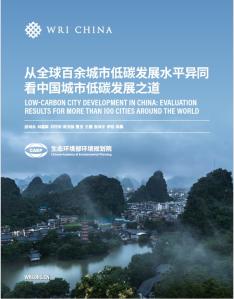Low-carbon city development in China: evaluation results for more than 100 cities around the world
This report constructs an indicator evaluation system from the perspective of low-carbon production, low-carbon consumption, low-carbon environment, and low-carbon progress. It innovatively selects 11 typical indicators, such as the low-carbon information index and carbon productivity, and evaluate the low-carbon development of 102 cities around the world (43 international cities and 59 domestic cities).
This report is jointly completed by World Resources Institute (WRI) and the Chinese Academy of Environmental Planning of the Ministry of Ecology and Environment. It constructs an indicator evaluation system from the perspective of low-carbon production, low-carbon consumption, low-carbon environment, and low-carbon progress. We innovatively select 11 typical indicators, such as the low-carbon information index and carbon productivity, and evaluate the low-carbon development of 102 cities around the world (43 international cities and 59 domestic cities). Specifically, low-carbon production is used to represent the city's low-carbon performance in the production process, low-carbon consumption measures the low-carbon consumption behavior of city residents, low-carbon environment is used to characterize the degree of harmonious coexistence between the city and the natural and ecological environment, and low-carbon progress is used to highlight some of the low-carbon development progress of cities. The evaluation of low-carbon city development was carried out under a unified standard. The weighting of the indicators is based on a combination of "subjective" and "objective" approaches—with the subjective approach based on the scores of top research scholars in the related fields and the objective approach based on the entropy weighting method—to ensure the authority and science of the indicator weights. Meanwhile, to further explore the low-carbon development direction and path of different types of cities, cities are classified into different categories based on the Köppen climate classification and the industrial structure and international status of the cities; this facilitates better comparative analysis and provides a reference for the low-carbon development of Chinese cities.
The final results of the report will be posted on the Citysphere platform, which is developed by WRI and other partner organizations. Citysphere is a visualization platform that showcases and evaluates cities' climate goals, policies, low-carbon progress, and so forth to drive cities to achieve climate ambitions and accelerate the low-carbon transition.
Projects

Citysphere
Launch PlatformLaunch Platform Visit ProjectA visualization platform that comprehensively showcases and assesses cities’ climate goals, low-carbon progress, etc. to drive cities to achieve climate ambitions and accelerate low-carbon transitions.
Part of Sustainable Cities
